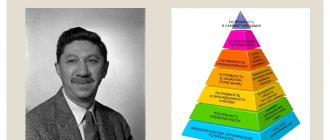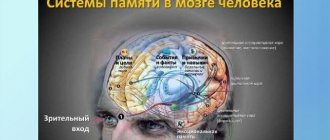The Great Ego
Attitudes towards personality in Soviet and Western schools of psychology were under pressure from ideology. In the USSR, psychology had to provide evidence of the correctness of the ideas of collectivism.
In Europe and America, psychologists were in demand as private and corporate consultants. Therefore, much more research has been devoted to personality and its self-identification.
Several main directions have emerged:
- Psychoanalysis.
- Behaviorism.
- Cognitivism.
- Symbolic interactionism.
The existence of different schools and competition between them reflects the complexity of the problem. A person turns to a psychotherapist and psychoanalyst when he realizes that something is “wrong” in his life. Loss of self-identity causes discomfort and stress.
Each person is individual. Differences in approaches to diagnosis and therapy allow everyone to find a specialist whose methods are most effective in a particular situation.
Levels of self-identification
In psychology, the following levels of self-identification are distinguished:
- Social-professional. It is defined, for example, by the following statements: “I am a teacher,” “I am successful and respected,” “I am rich and famous.” For example, by self-identifying as a teacher, a person means that he is teaching the younger generation, and therefore unconsciously expects respect from others.
- Family-clan. Here self-identification is expressed, for example, as “I am a mother,” “I am a spouse,” “I am a member of a tribe.”
- National self-identification. At this level, each person can define himself by several concepts at once, for example: “I am Russian, I live in the Arkhangelsk region, I am from Severodvinsk.”
- Value-ideological. Here a person defines himself as a person belonging to such groups as Muslims, Orthodox Christians, atheists, pacifists, democrats and others.
- Evolutionary-species. Everyone can say to themselves: I am a human being. And this is also self-identification, since the individual recognizes himself as belonging to a certain species of living beings.
In addition to these large levels, there are other criteria for self-identification, for example: by hobbies, favorite music, interests, health, bad habits, and even by food preferences - vegetarians and meat-eaters. What is the peculiarity of personal self-identification? The fact is that over time a person can attribute himself to different parts of society, and also simultaneously define himself as a member of several groups at once.
Psychoanalysis
Freud viewed the process of self-identification as two opposing processes. Acceptance of what creates a feeling of comfort (“anaclitic” identification). And protection from everything frightening and incomprehensible (“identification with the aggressor”).
The illustration shows Freud's personality structure. Ego - subconsciously, Id - the sphere of receiving pleasure, Super-Ego - self-restraint (ethics, morality).
Freud put forward a theory of five stages of human development. He associated them with the predominance of physiological reactions in different periods of childhood. According to his theory, too strong a fixation on the functions of the body at the beginning of life leads to disturbances in the self-identification of a mature personality.
Erik Erikson, a follower of Freud, proposed a theory of 8 stages of psychosocial development, from infancy to old age. It has become widespread, since in its main provisions it corresponds to “common sense” and the personal experience of the majority.
Infancy . Building trust in the mother and the environment. According to observations of children in families and shelters, it is important for infants to have a person with whom emotional contact is established. Children deprived of communication begin to lag behind in development even with proper care and feeding. In adulthood, it is difficult for them to communicate and identify themselves as an independent, self-sufficient person.
Early childhood up to 3 years . According to Freud, this is the anal period when the child becomes aware of control over bowel movements. According to Erikson, at this age independence and awareness of physical capabilities are formed. The child masters the first self-service skills: eating, dressing, etc. Limiting activity at this age leads to weakness of will.
Game age from 3 to 6 years . The child actively explores the world, masters systems of norms and restrictions. There is an awareness of guilt for violating prohibitions, shame, pride, initiative in games and communication. The Super-Ego is formed. According to Freud, this is a component of personality responsible for norms of behavior and moral attitudes. At the level of everyday experience, it has long been known that strict prohibitions or permissiveness in childhood form a person’s distorted ideas about himself.
School age up to 12 years . The period of the first encounter with society without parental support. Acquiring communication skills, awareness of one’s status in the hierarchy of peers. The discrepancy between the expectations of adults and the real successes of the child forms an inferiority complex. Its manifestations in adulthood become a reason for turning to psychotherapists.
Adolescence . Physiological and hormonal changes occur. The teenager seeks to leave his family and socialize in society. Since in the modern world a teenager is considered a child and continues to depend financially on his parents, the process gives rise to conflicts. Identification of oneself among others, the formation of independent goals and desires are postponed. This is expressed in infantilism, which must be overcome in maturity.
The period of youth lasts up to 25 years . A person’s ability to start a family depends on how the previous stages of personality formation were completed. The lack of experience of emotional intimacy in a previous life leads to loneliness, disappointment, and psychological problems.
Maturity . Lasts until 60-65 years. A person realizes himself in a profession and other forms of social life. Self-identification as a parent is very important. Throughout the entire period of maturity, a person experiences various crises of self-identification. This serves as a source of development (career and professional growth, change of activity, creativity).
Old age . Exhaustion of resources, acceptance of oneself and one’s role in society and family.
E. Erikson saw normal personality development in the consistent overcoming of crises of transition from one psychosocial stage to the next. All tasks of the period must be completed. Otherwise, an adult remains in the “child”, “teenager” stage. His priority becomes the search for emotional attachment or his social group. According to Erikson, identity is a sign of a mature personality.
Development mechanism
Identification develops in several stages. The first occurs at the age of about 3 years, when the child begins to understand that he and his mother are not one whole, that another person is vying for the mother’s attention - the father. The child cannot compete with him for his mother, so he needs to develop paternal qualities in himself. This will allow later, already in adulthood, to win a “mother” - a woman who will become a companion.
The second stage of identification development occurs during adolescence. The period of separation is the time when a teenager moves more and more away from his parents and is left alone with the big world. To find external support, he needs another person or group with which to identify.
In the process of identification, a person gains new experience, acquires qualities that later help him determine his own vector of development. With the help of identification, a young child develops personal characteristics and behavioral patterns, and begins to understand his gender identity. Focusing on a meaningful image helps to overcome the feeling of one’s own weakness and inferiority.
Personal identification in behaviorism
Behaviorism – practical application and development of I. Pavlov’s ideas. Human behavior is considered as a system of reactions to the environment. Personal identification and conscious behavior in accordance with the chosen strategy are considered the highest human development.
Most people don't try to understand themselves as individuals. They live and act in accordance with subconscious programs learned in early childhood through copying. Their social identification comes down to the assimilation of patterns of behavior and stereotypes accepted in their environment. Social approval is a form of reinforcement.
A purely materialistic, almost biological approach to the motivation of human actions caused rejection in the scientific community. But the application of behaviorism methods in pedagogy, marketing and propaganda gives the expected result.
Definition of the concept
Self-identification is the basis of one’s “I”, an assessment of one’s own abilities, personality traits, personal, physical and moral characteristics. Each person determines for himself how capable he is of performing a particular activity, achieving goals, displaying feelings or physical qualities. Based on this data, a person can classify himself as a member of one or another group: religious, sports, intellectual and others. For example, a person who is aware of his ability to draw may classify himself as an artist, and someone who sees himself as having excellent physical abilities identifies himself as an athlete. The only way for a person to self-identify is reflection: only by deeply reflecting on himself can a person understand who he is, what he wants and where he is going.
Cognitive approach
In contrast to behaviorism, the study of personality draws an analogy between the brain and a computer. The theory was developed at the intersection of psychology, cybernetics and linguistics. It is believed that all impressions from interactions with the outside world are structured. So-called “constructs”—models of reality—are formed. Each person has his own set of constructs and connections between them. They regulate behavior and self-identity.
From cognitive psychology, the expression “cognitive dissonance” has come into widespread use. This is the discrepancy between objective reality and the individual's personal experience.
In cognitivism, the theory of social identity (SIT) has been developed. For any individual, socialization is associated with the process of categorization, or comparison of one’s qualities with the qualities of representatives of a group. Such a comparison is only possible through communication. Interpersonal and intergroup interaction is considered as a cognitive process. As a result, the number of behavioral models that simplify social adaptation is expanding.
History of discovery and study
The term “identification” has different interpretations and features. According to the teachings of Sigmund Freud, these are:
- A defensive reaction due to fear of punishment for aggressive or sexual desires.
- The unconscious identity of one subject with another, the motive of which is reflected in the fear of losing love.
In psychoanalysis, identification is emotional. It is the only mechanism by which personality is formed. At an unconscious level, the parental prototype is reproduced.
From the point of view of behaviorists, identification is associated with the concept:
- role theories;
- formation, reinforcement of secondary needs;
- cognitivism.
Identification manifests itself at a conscious and unconscious level.
Symbolic interactionism
Adherents of this paradigm in sociology believe that a person reacts not to direct stimuli, but to their images. Language is considered the main symbolic system. “Understanding” by group members of each other without words is explained by the fact that the primary interaction is gesture and facial expressions.
Since a person cannot form and develop outside of society, he self-realizes in the process of interactions, “interactions.” Personality manifests itself only as a result of communications. The exchange of people’s ideas about themselves and others forms a “primary group” with the closest and most effective connections.
The personality is in constant dynamics: assessing the situation, its correlation with familiar symbols and in the interaction or exchange of symbols.
Stages
Stages of identification from forensic science:
- Preparation. Experts must study the available data about a specific person, evaluate the information, and weed out useless and false information. If there is enough information, a research plan is drawn up and technical means are prepared.
- Analytics. The specialist begins to study the properties, signs of objects and subjects that are involved in the case.
- Experiment. It is needed to obtain samples of the subjects being studied.
- Comparison. Stage of object identification.
The last stage is summarizing the information received, analyzing it, drawing conclusions, and recording the results. The results of the examination are recorded in special acts.
Social identification in the modern world
Realizing and identifying himself, a person necessarily correlates his “I” with any group. This identification can be a source of positive emotions. Awareness of belonging to a low-status group generates feelings of shame. For example, it is not prestigious to be “poor”, “poorly dressed”, “weak”.
Reluctance to belong to a low-status group is expressed in several ways:
- Active protest, aggression towards representatives of other groups, demonstration of “bad” qualities.
- Assimilation, the desire to outwardly resemble representatives of social strata with a higher status.
- The search for compromises, borrowing the features of another group or culture, while demanding to “respect” certain norms of behavior of one’s social stratum.
Self-identification is based on a common mentality (civilizational identity). These are the same traditions and norms for large groups of people, learned in childhood. People with the same mentality understand each other more easily, even if they speak different languages.
But in second place is ethnicity . It becomes a problem for representatives of nations and peoples who are considered or consider themselves disadvantaged.
The third most important is age identification . This is a problem for teenagers, since the desire to occupy a higher position as an “adult” does not correspond to life experience. For older people, awareness of their age is painful because it is associated with the loss of the achievements of a previous life.
Methods
Experimental methods of research in most cases focus on specific aspects - social roles, gender or group affiliation, personality characteristics. Such studies make it possible to identify the peculiarities of living certain identities and searching for a significant object for identification in different situations and areas of activity.
Difficulties arise when it is necessary to study not specific characteristics, but to form a holistic picture of the personality and its identity.
In order to explore the widest possible range of manifestations of identity, to understand with whom, with what and to what extent a person identifies himself, several diagnostic directions are used:
- Questionnaires to identify the level of attitude towards oneself and self-satisfaction. They are easy to use, easy to standardize and validate on a representative sample. Limitations to obtaining objective survey results may include cognitive biases related to self-perception, as well as socially desirable responses.
- Psychosemantic research methods - in them, the assessment of one’s own personality is considered through compliance with a certain set of criteria, which are not always socially approved.
- Projective techniques - they provide an opportunity to explore identity and self-awareness.
Loss of personal identity
At any age, loss of personal identity can occur. It may have external or internal causes. The first include such as loss of a job or loss of social status. The second is a change in interests, loss of previous values, a global revision of life goals. Regardless of the reason, when self-identity is lost, a person loses his place in some social groups in which he previously felt comfortable. A person must look for new life goals and his new place in society for a successful future. Otherwise, there is a high risk of personality degradation, the acquisition of any kind of addiction or the development of severe depression.
Pain points of personal identity
What are the painful points of a person’s self-identification? These are those characteristics of an individual that a person knows about, but considers them negative traits. For example, at the socio-professional level of self-identification, this may be the lack of a specific skill necessary in professional activity, and at the level of values and ideology - excessive love for animals combined with relative indifference to people’s troubles. When communicating with other people, a person experiences psychological discomfort if he has to talk about “painful” topics relating to his personality.
Examples
Personal self-identification, including in the Western tradition, includes a person’s self-determination to one group or another, an assessment of one’s own capabilities and an analysis of the life path traveled. At the same time, a person can belong to several groups at the same time according to different criteria. For example:
- by profession and social status: doctor;
- by marital status: spouse, mother, daughter;
- by nationality and area of residence: Russian, Muscovite;
- in terms of values and ideology: Orthodox, committed to the peaceful resolution of conflicts, considers her family to be her main life value;
- Hobby: needlewoman;
- according to musical preferences: loves bard songs and Russian rock.









